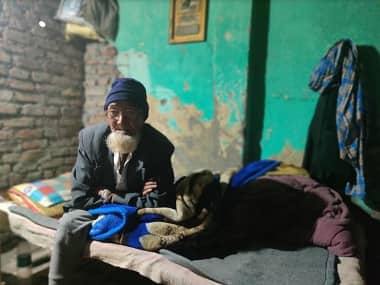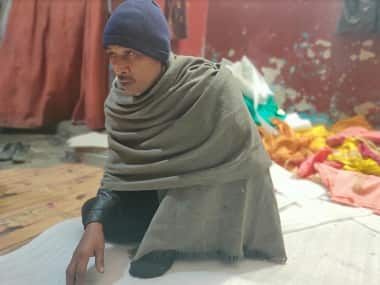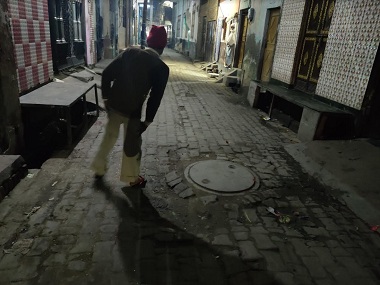He adjusted his muffler and rearranged the ski cap on his head before stepping out of the little grocery store. “It’s time to shut shop and join the group,” Anees could see his own breath when he uttered those words. In the biting cold, he walked through the pitch-dark narrow street dotted with one-room houses and open sewers running alongside. A few hundred metres on, around 10 to 15 men had gathered around a bonfire at the crossroads. They planned to spend the night there guarding the area from the police. Residents of what is called the Ahmednagar area in the town of Meerut in West Uttar Pradesh have been at it for a month. “We do not want the police to barge into our homes late in the night and disturb women and children,” said Anees. “If the police arrives, we present ourselves and talk to them.” On 20 December, 2019, protests opposing the Citizenship Amendment Act (CAA) and National Register for Citizens (NRC) turned violent in several parts of Uttar Pradesh. Twenty-three protesters have died so far in the state — all Muslims. Six of them were killed in Meerut. Harrowing reports of police brutality and religious profiling by the police have emerged since then. [caption id=“attachment_7950731” align=“alignleft” width=“380”] Mohammad Salauddin patrols his neighbourhood after most residents are in their homes. Firstpost/Parth MN[/caption] Three of the six killed in Meerut lived in the Ahmednagar area. Ram Arj, Superintendent of Police, Crime, Meerut, said the police has so far arrested 56 people, and “a lot of arresting remains to be done.” He added, “The police has not harassed anyone, we are investigating and doing our job.” But residents say the three killed in the Ahmednagar area died of bullets fired by the police, and since their deaths, the police has been “harassing common citizens and framing innocents to absolve itself from culpability”. “Ever since that day, we have hardly managed to get any sleep,” said Anees, hunched over, rubbing his palms against each other and holding them over the bonfire to stay warm. “The police presence is supposed to be reassuring. Here, its behaviour has ensured people get terrorised instead.” Mohammad Salauddin, 35, who lost his brother Aleem, 24, said the police fired at protesters to kill. “If they wanted to placate protests, they could have fired below waist-height,” he said, sitting in his dimly-lit home. Aleem, he said, took a bullet to the head, and died on the spot. “The police initially said he died because a stone smashed into his head. But his head was split wide open. A stone does not cause that.” Aleem worked as a cook at a roadside eatery. Salauddin, who washes utensils at another hotel, has still not received the post-mortem report. He is physically-impaired, and it is even more troublesome for him to keep running around. “We carried out his funeral the following night,” he said, “I, along with three relatives, claimed the body. None of my friends or neighbours came along because they were scared of being targeted by the police.” [caption id=“attachment_7950751” align=“alignright” width=“380”]
 Salauddin’s father Habib. Firspost/Parth MN[/caption] That anxiety the night after the unrest still lingers on a month later. Parvez, sitting next to Anees around the bonfire, said a cat jumped on his roof the other night, and the noise made him wonder if it was the police raiding the area. “When I saw the cat, I heaved a sigh of relief,” he said, “Our mental peace has been completely disturbed for the past month. Belonging to a particular religion is enough to be a suspect these days. When a few of us opened up to each other about it, we thought of this idea of gathering every night, and watching over the area. We do it until sunrise in rotation.” The residents know they are powerless, and their patrolling is hardly an impediment if the police decides to use force and have its way. A few residents have been picked up during the day. The nights basically create an illusion of fortification. “We are aware of it,” said Anees, matter-of-factly, “But we feel a bit of reassurance in a group. At home, with family members, we feel exposed and insecure.” The whole ordeal has exacted an economic cost on the residents. “The market and shops here used be open and bustling till 1 am,” said Anees, “But, for the past month, there is pin-drop silence after eight or nine o’clock at night. Nobody wants to stay outdoors after sunset. And nobody wants to be seen especially around this area.” Along with shopkeepers, daily-wage labourers have also been hit economically by the social strife. Jafar, 17, said his parents do not let him work outside the area, or after sunset. “There are power looms and factories that run 24 hours a day,” he said. “Now I have to get work in power looms in our area and that too during the day. It has restricted my opportunities, but my parents are adamant. They fear I won’t return if I go too far. The paranoia is serious. People have also stopped attending weddings out of fear of being late.” [caption id=“attachment_7950741” align=“alignleft” width=“380”]
Salauddin’s father Habib. Firspost/Parth MN[/caption] That anxiety the night after the unrest still lingers on a month later. Parvez, sitting next to Anees around the bonfire, said a cat jumped on his roof the other night, and the noise made him wonder if it was the police raiding the area. “When I saw the cat, I heaved a sigh of relief,” he said, “Our mental peace has been completely disturbed for the past month. Belonging to a particular religion is enough to be a suspect these days. When a few of us opened up to each other about it, we thought of this idea of gathering every night, and watching over the area. We do it until sunrise in rotation.” The residents know they are powerless, and their patrolling is hardly an impediment if the police decides to use force and have its way. A few residents have been picked up during the day. The nights basically create an illusion of fortification. “We are aware of it,” said Anees, matter-of-factly, “But we feel a bit of reassurance in a group. At home, with family members, we feel exposed and insecure.” The whole ordeal has exacted an economic cost on the residents. “The market and shops here used be open and bustling till 1 am,” said Anees, “But, for the past month, there is pin-drop silence after eight or nine o’clock at night. Nobody wants to stay outdoors after sunset. And nobody wants to be seen especially around this area.” Along with shopkeepers, daily-wage labourers have also been hit economically by the social strife. Jafar, 17, said his parents do not let him work outside the area, or after sunset. “There are power looms and factories that run 24 hours a day,” he said. “Now I have to get work in power looms in our area and that too during the day. It has restricted my opportunities, but my parents are adamant. They fear I won’t return if I go too far. The paranoia is serious. People have also stopped attending weddings out of fear of being late.” [caption id=“attachment_7950741” align=“alignleft” width=“380”] Eid-ul-Hasan. Firstpost/Parth MN[/caption] The night that this reporter visited the area was eerie and tensions were simmering in the air. Normalcy seemed like a fantasy for the residents living on the edge. Eid-ul-Hasan, 48, had spent the day in unsuccessfully trying to get the post-mortem report of his son, Asif, who died at the age of 20. “I have been running from pillar-to-post, but I have not yet received any concrete answers,” he said, “They keep asking me to go from one police station to another.” Asif used to drive an e-rickshaw to help the family make its ends meet. When the protests turned violent, Hasan said, he was caught in the middle of nowhere. “He took a bullet to the chest,” he said, adjusting his shawl around his upper body. “Those who took him to the hospital told me he fell to a police bullet.” Hasan too joins the group at night sometimes after his work — especially when he feels lonely. He has to wrap an extra shawl around himself and ensure his ears are not exposed through his torn ski cap. But winters are a small price to pay, Hasan said. The group around the bonfire may not be providing immaculate protection, but it offers much needed solace.
Eid-ul-Hasan. Firstpost/Parth MN[/caption] The night that this reporter visited the area was eerie and tensions were simmering in the air. Normalcy seemed like a fantasy for the residents living on the edge. Eid-ul-Hasan, 48, had spent the day in unsuccessfully trying to get the post-mortem report of his son, Asif, who died at the age of 20. “I have been running from pillar-to-post, but I have not yet received any concrete answers,” he said, “They keep asking me to go from one police station to another.” Asif used to drive an e-rickshaw to help the family make its ends meet. When the protests turned violent, Hasan said, he was caught in the middle of nowhere. “He took a bullet to the chest,” he said, adjusting his shawl around his upper body. “Those who took him to the hospital told me he fell to a police bullet.” Hasan too joins the group at night sometimes after his work — especially when he feels lonely. He has to wrap an extra shawl around himself and ensure his ears are not exposed through his torn ski cap. But winters are a small price to pay, Hasan said. The group around the bonfire may not be providing immaculate protection, but it offers much needed solace.
Residents of what is called the Ahmednagar area in the town of Meerut in West Uttar Pradesh have been patrolling their neighbourhood at night for a month
Advertisement
End of Article
Written by Parth MN
Parth MN is a freelance journalist based in Mumbai. He predominantly covers agriculture along with politics and current affairs. He has been awarded the Lorenzo Natali Media Prize by the European Commission. see more


)

)
)
)
)
)
)
)
)



